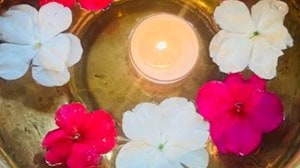Redness of Kashmiri Chilli
A celebration of the cuisine from gentle haak to vivacious pacch ras
Once upon a time in Srinagar,there were evenings when women would gather at the bay windows (dub in Kashmiri) on the top floor of their houses to have long conversations with neighbours. As the hearths burned,dinner secrets spilled on to the narrow lanes. Especially if they had cooked gaad te nadir (fish cooked with lotus stems),pachh ras (trotter soup) or simply razma dal that day. In the densely inhabited localities of Habba Kadal,Barbarshah and Rainawari,they would exchange recipes and weigh ingredients. That was the time when food came more often from the backyard than the bazaar. That was the time when Pandits and Muslims lived together,unsegregated,in the Valley and food exemplified that bond.
After 1989,with the outbreak of the azadi movement,the migration of Pandits and the reign of fear,Srinagars streets resonated only with the deafening rattle of gunfire. Close-knit localities of the past disintegrated,as a large chunk of Srinagars old residents chose to move to the suburbs and build modern houses in relative privacy.
Sarla Razdans book on the Kashmiri cuisine retrieves that past. It is a relief,because it moves away,at least momentarily,from the sense of perennial conflict that Kashmir now evokes. It is a relief,because while books,reports and conversations over the past two decades have invariably centred on violence and bloodshed,this book touches on another lived reality of the place,of the essential Kashmir its food.
Razdan gathers a range of traditional Kashmiri preparations. There is the austere haak batta collard greens and rice,it is Kashmirs ultimate vegetarian dish which has also become a metaphor for a typical Kashmiri outlook on life,a certain philosophy of simple living. And then she moves on to the variegated,combustibly spice-laden wazwan which can run into dozens of courses. Send us haak batta is a prayer that goes up in every Kashmiri home,Pandit and Muslim. It reflects contentment and is a gentle protest against greed.
What add to the book are its photographs that hark back to a lost Kashmir,its gentle shades and pastoral innocence images of shawl weavers,tailors and embroiders at work under the shade of chinar,traders on wooden boats at the ghats of the Jhelum and the houseboats on the Dal lake retrieving thereby a lost geography of peace.
In Kashmir,we have,as a photograph shows,festoons of red chillies hanging from the eaves of thatched mud huts,presiding over a sunlit courtyard bustling with women in traditional pherans. These chillies,as the winter approaches,are ground to a pungent powder that lends a dish a tongue-tingling flavour,a mild fieriness of Kashmir soil. Except yakhni,that sumptuous,mushy blend of lamb and yoghurt,the chilli is a staple spice in almost all dishes. And that is why the colour of Kashmiri food is invariably red.
However,the books merit lies in reproducing an authentic menu of Kashmir. While the book will help you reproduce that,there is more to it. For Razdan,it is a fond celebration of traditional Kashmiri food and an assertion of her roots. For those in the Valley,it is a memory project. For in food,all differences disappear,give or take a spice or two.





- 01
- 02
- 03
- 04
- 05


























